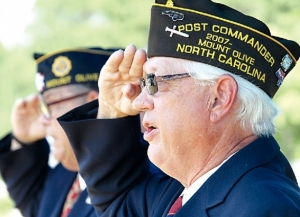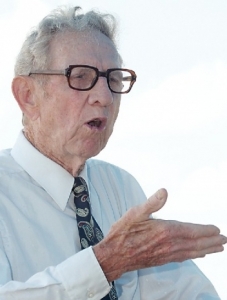Veteran recalls service at memorial to fallen
By Steve Herring
Published in News on May 30, 2011 1:46 PM

News-Argus/TROY HERRING
VFW Post 9959 Commander Richard Hansen salutes an American flag before the start of the Memorial Day tribute Sunday at Maplewood Cemetery in Mount Olive.

News-Argus/TROY HERRING
U.S. Air Force retiree Hugh Howard shares his experiences as a soldier during World War II.
MOUNT OLIVE -- Hugh Howard was just two days shy of his 22nd birthday when the B-17 on which he was a crew member was shot down over Germany in 1944. Captured by the Germans, Howard spent the next seven months in a POW camp, at one point being moved just ahead of the approaching Russian Army.
Howard, now 87, Sunday afternoon shared his story with the nearly 100 people who had gathered at Maplewood Cemetery to pay tribute to those who have made the ultimate sacrifice in the name of freedom.
Small flags placed on the graves of veterans Saturday morning fluttered in a light breeze that provided some relief from the 90-degree weather during the annual Memorial Day ceremony sponsored by VFW Post 9959 and American Legion Post 103.
Howard said he was honored to be asked to speak and answered questions about his service in the military. A native of Davie County, Howard served in World War II and the Korean Conflict, retiring after 30 years in the Air Force.
He was a gunner and engineer on a B-17 that flew bombing missions over Europe when his plane was shot down near Cologne, Germany on Oct. 15, 1944.
Howard was a POW for about seven months before being liberated by U.S. forces on April 29, 1945. Howard said he was not mistreated by the Germans even though the prisoners were not fed well. The regular German Army soldiers could be friendly, but not the SS, he said.
"December, January and February we had noise that we began to pick up -- boom, boom, boom, boom," he said. "The Germans got all nervous about it and come to find out the Russians were about 10 to 12 miles east of us. They said, 'get going.' They took about 1,500 people out of 7,000 or 8,000 who couldn't walk. They took the first train out with about 50 boxcars and loaded them. They came back the next day and moved us to another town.
"About 4 o'clock in the morning the train stopped. We had about 15 to 20 people who had to stand up always so there was room for those who wanted to lie on one side. We were stacked in there like wood. At 7 o'clock the guards woke us up, emptied the slop jar. The guy who emptied it came back and said there is no engine. We sat there three days on the tracks -- no engines, no food, no water."
Howard said they didn't know what was going to happen, but that the engines finally returned. The trains couldn't run during the daytime because Allied aircraft would attack them, he said.
"Most of the trains had POW marked on them, but the fighters that strafed them couldn't see them until they got right down on them," he said. "It took us 11 days to get from Stalag Luft 4 to get to Nuremberg. It had the most flea-bitten place that we had ever seen."
Snow was on the ground and the POWs had not had a change of clothes in three months.
"If you felt one (flea) biting you, you squeezed him and it would leave blood on your clothes," he said. "We finally got a chance to do some laundry then one morning we heard boom, boom, boom, boom again. The Germans come running by and said they were moving us. This was the Americans.
"We started marching and marched for three weeks and we went to Moosburg, which was Stalag 7A about 30 miles north of Munich, that is where we were for about five days before the American Army overtook us."
Among those American forces was Gen. George S. Patton with a staff of about a dozen who came through inspecting every barracks and every tent at the camp, Howard said. The former POWs also had decent meals for the first time in months.
They remained at the camp for seven days before being moved out, ending up in Reims, France.
The POWs returned to England and while at Southampton a Navy chief asked for volunteers to work on a ship. He didn't get any. He asked the second time and received the same response.
"Most were POWs and they weren't interested in working," Howard said. "He asked if anyone wanted to take a tour of the ship. We were all anxious. We went through that ship and they had 2,200 wounded soldiers. Everyone had to be fed individually.
"He said, 'Does anyone want to work?' Everyone on that tour wound up volunteering for a job."
Organizers of Sunday's service said they were pleased with the turnout, but at the same time they lamented the public's failure to give the holiday and the veterans it represents the reverence they deserve.
"What this should mean to everybody is to honor all of those who have died in past wars," Post 103 Commander Pete Kascsak said. "Every grave out there that is marked as a veteran we put a flag on it. It has been such an honor to come out here and help put these flags out. If anyone needs a flag to put on a grave. I am always available just look me up in the phone book and I will get a flag."
Kascsak said flags were placed on graves of all known veterans. In some cases, the tombstones do not denote whether the person was a veteran, he said. To get a grave marker, people should submit a DD 214 form to Veterans Affairs.
